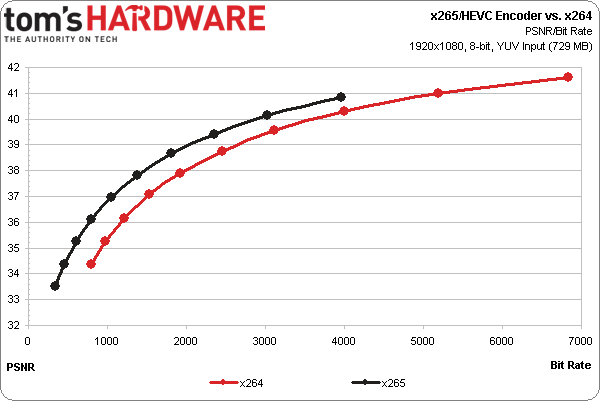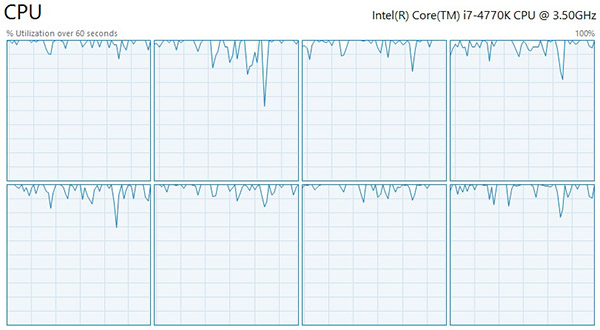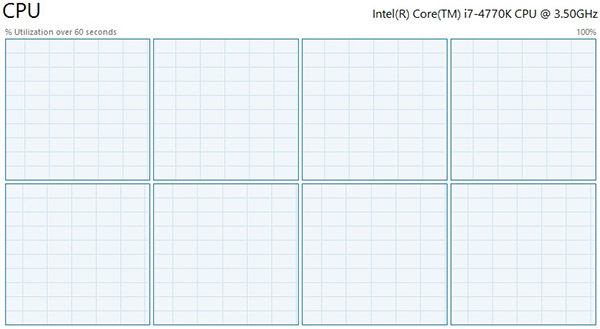Next-Gen Video Encoding: x265 Tackles HEVC/H.265
Last month, the HEVC/H.265 standard was officially published. We recently got our hands on a pre-alpha build of x265, an HEVC encoder project from a company called MulticoreWare that's going to be licensed in much the same way as the famed x264 library.
x265 Versus x264 And CPU Utilization
The idea is that HEVC should allow you to encode video at similar quality levels and lower bit rates. MulticoreWare is currently estimating 25 to 35% lower bit rates at a given PSNR. However, its developers are also adamant that as they add those aforementioned features, encoding efficiency will improve.
With that in mind, let’s take a quick peek at how pre-alpha x265 stacks up against the well-optimized x264. For this one, we're using the following command: x264 --preset placebo --sar 1920:1080 --fps 24 --frames 500 --psnr -o x264Kimonoq24.264 Kimono1_1920x1080_24.yuv, again with quantization parameters between 24 and 42. We could have used the --tune psnr switch to generate higher values, though this negatively affects subjective quality compared to the settings used here.
At each point on the curve, you can either get better quality for a given bit rate from x265, or the same quality at a lower bit rate.
We know that other HEVC encoders will emerge, and our benchmark suite will likely evolve to phase out the several H.264-based tests as this happens. But more immediately, we’re excited to have x265 as the first in our test lab, taxing high-end hardware more intensively than most of the other metrics we use. In fact, I screen-capped both workloads in action and consistently saw x265 pegging our Haswell-based test mule at 100% utilization, while x264 bounced around quite a bit more.
By the time you read this, MulticoreWare should have more information up at x265.org.
Get Tom's Hardware's best news and in-depth reviews, straight to your inbox.
-
Jindrich Makovicka In addition to PSNR comparison, I'd be much more interested in the SSIM metric, which is better suited for codecs using psychovisual optimizations.Reply
PSNR can be usable for when testing varying parameters for one codec, but not so much when comparing two completely different codecs. -
CaedenV Nice intro to the new codec!Reply
And to think that this is unoptomized... Once this is finalized it will really blow 264 out of the water and open new doors for 4K content streaming, or 1080p streaming with much better detail and contrast. This is especially important with the jump to 4K video. The 16x16 grouping limit on x264 is great for 1080p, but with 4K and 8K coming down the pipe in the industry we need something better. The issue is that we really do not have many more objects on the screen as we did back in the days of 480i video, it is merely that each object is more detailed. Funny thing is that a given object will typically have more homogeneous data across its surface area, and when you jump form 1080p to 4K (or 8K as is being done for movies) then it takes a lot more 16x16 groupings which may all relay the same information if it is describing a large simple object. Moving up to 64x64 alone allows for 8K groupings that take up the same percentage of the screen as 16x16 groupings do in 1080p. -
nibir2011 Considering the CPU Load i think it wont be a viable solution for almost any home user within next 2-3 years unless CPUs gets exceptionally fast.Reply
Of course then we have the Quantum Computer. ;) -
Shawna593767 Quantum computers aren't fast enough for this, the get their speed by doing less calculations.Reply
For instance a faster per clock x86 computer might have to do say 10 million calculations to find something, whereas the quantum computer is slower per clock but would only need 100,000 calculations. -
nibir2011 Reply11211403 said:Quantum computers aren't fast enough for this, the get their speed by doing less calculations.
For instance a faster per clock x86 computer might have to do say 10 million calculations to find something, whereas the quantum computer is slower per clock but would only need 100,000 calculations.
well a practical quantum computer does not exist . lol
i think that is not the case with calculation.i think what you mean is accuracy. number of calculation wont be different; it will be how many times same calculations need to be done. in theory a quantum computer should be able to make perfect calculations as it can get all the possible results by parallelism of bits. a normal cpu cant do that it has to evaluate each results separately. SO a quantum computer is very very efficient than any traditional cpu. Speed is different it depends on both algorithm and architecture. quantum algorithms is at its infancy. last year maybe a quantum algorithm for finding out primes was theorized. I do not know if we will see a quantum computer capable of doing what the regular computers do next 30 years.
thanks
-
InvalidError Most of the 10bit HDR files I have seen seem to be smaller than their 8bits encodes for a given quality. I'm guessing this is due to lower quantization error - less bandwidth wasted on fixing color and other cumulative errors and noises over time.Reply -
ddpruitt I know it's a minor detail but it's important:Reply
H.264 and H.265 are NOT encoding standards, they are DECODING standards. The standards don't care how the video is encoded just how it's decoded, I think it should be made clear because the article implies they are decoding standards and people incorrectly assume one implies the other. x264 and x265 are just open source encoders that encode to formats that can be decoded properly by H.264 and H.265.
x264 has noticeable issues with blacks, they tend to come out grey. I would like to see if x265 resolves the problem. I would also like to see benchmarks on the decoding end (CPU Load, power usage, etc) as I see this becoming an issue in the future with streaming video on mobile devices and laptops. -
Nintendo Maniac 64 You guys should really include VP9 in here as well, since unlike VP8 it's actually competitive according to the most recent testing done on the Doom9 forums, though apparently the reference encoder's 2-pass mode is uber slow.Reply



